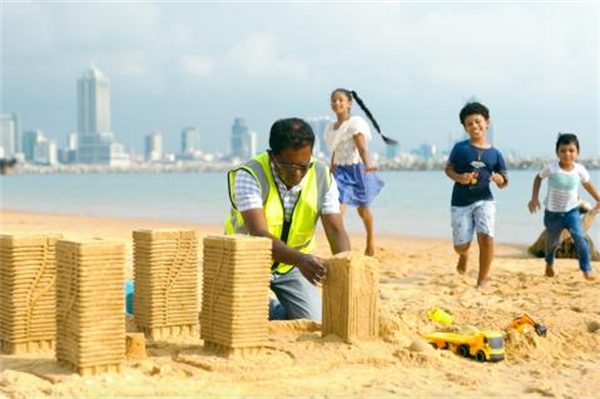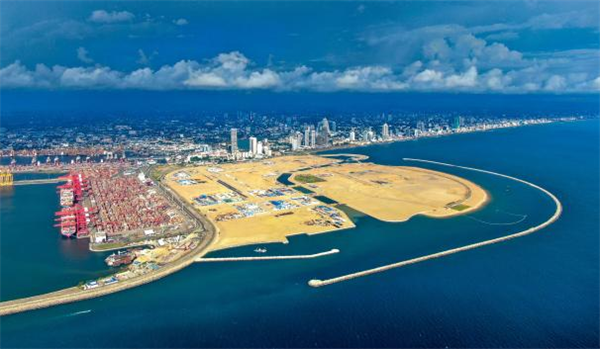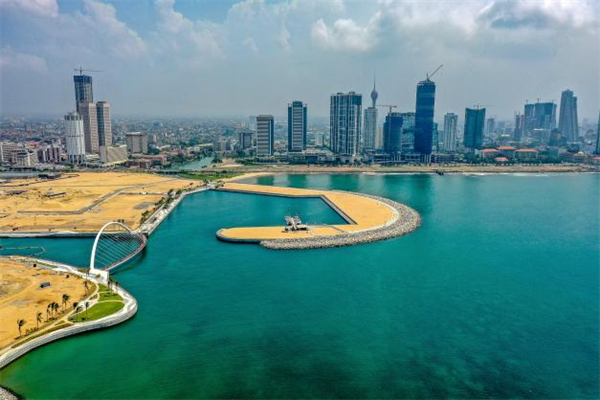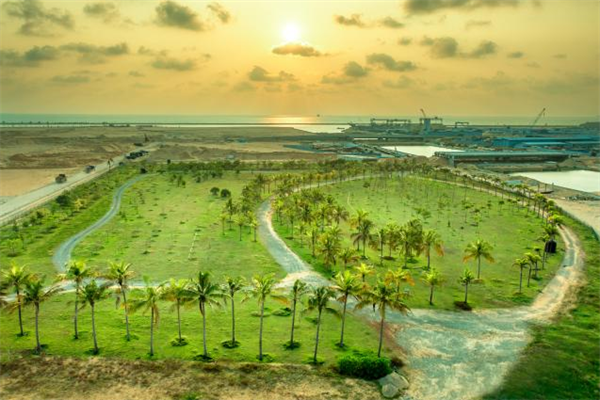"Sir, what are you making?" three children asked Sanjeewa Alwis, an electrical and mechanical engineer of the Colombo Port City in Sri Lanka, when they met on a sunny weekend on the beach.
"I am building a sandcastle of a financial center. In the future, many buildings will appear on the beach. You might not have imagined that this place is actually made of reclaimed land from the Indian Ocean and that a new city will be rising from the ocean," said Sanjeewa.

Sanjeewa Alwis (1st L), an electrical and mechanical engineer of the China-funded Colombo Port City in Sri Lanka, builds a sandcastle on the beach when three children approach him. [Photo provided by CCCC]
A new city rising from the ocean
Sri Lanka is an island country in the Indian Ocean. It was an important stop on the ancient Maritime SilkRoad and has become widely known as the Jewel of the Indian Ocean.
Colombo was a world-class port several hundred years ago. It now has become Sri Lanka’s political, economic and cultural center.
The rapid growth in the number of people and the insufficiency of land available in Colombo have forced the Sri Lankan government to find solutions from land reclamation.

An aerial photo of the Colombo Port City project in Sri Lanka [Photo provided by CCCC]
In Sept 2014, the China Harbour Engineering Company Ltd. (CHEC), a subsidiary of the China Communications Construction Company Limited (CCCC), started to built the Colombo Port City project, which is the largest investment ever made by a Chinese enterprise in Sri Lanka. It stands as the country's largest infrastructural project with foreign direct investment and will fundamentally promote the development of bilateral ties.
According to its master plan, the Colombo Port City project is aimed at building a brand-new central business district integrating tourism, financial, logistics and living functions in a span of 25 years.
At present, the unprecedented project in Sri Lanka's history has shown its unique charm and beauty.
Chinese technology vital to the land-reclamation project
Many people often ask how to reclaim such a large land segment from the Indian Ocean and build so many high-rise buildings along the beach.
During its construction process, the CHEC dispatched four large-scale and advanced dredging ships to accomplish the Colombo Port City project. These fully automatic machines can excavate 250,000 cubic meters of sand on a daily basis, capable of burying a standard soccer pitch 35 meters deep.
Additionally, Chinese construction workers built a 3,245-meter-long breakwater to protect the city.
A city of the future with bright prospect
In January 2019, the Colombo Port City project reached a milestone with the reclamation of 269 hectares from the Indian Ocean. "I came to the land on a special tour that day. It is unimaginable and amazing," said Pariha Wadna, a clerk secretary of the infrastructural project.

An aerial photo shows the view of the yacht pier area and seashore pedestrian avenues of the Colombo Port City project in Sri Lanka. [Photo provided by CCCC]
The Colombo Port City opened its yacht pier area to the public on March 10, 2022, including seashore pedestrian avenues, artificial beaches and canals, and green parks.

An aerial photo shows the view of artificial green parks of the Colombo Port City project in Sri Lanka. [Photo provided by CCCC]
In the future, the Colombo Port City will accommodate the living and work of over 280,000 people and become a special economic zone, financial hub and a new city driven by its modern services industry.
In 2018, US Forbes magazine listed the Colombo Port City as one of the "five new cities to shake up the future".
"The Colombo Port City is a milestone project in the history of Sri Lanka. It will be a crucial growth engine of Sri Lanka and deliver numerous outcomes to the Sri Lankan people over several generations," said former Sri Lankan prime minister Mahinda Rajapaksa in an interview.

A photo shows of the Colombo Port City project in Sri Lanka. [Photo provided by CCCC]
(Executive editor: Wang Ruoting)